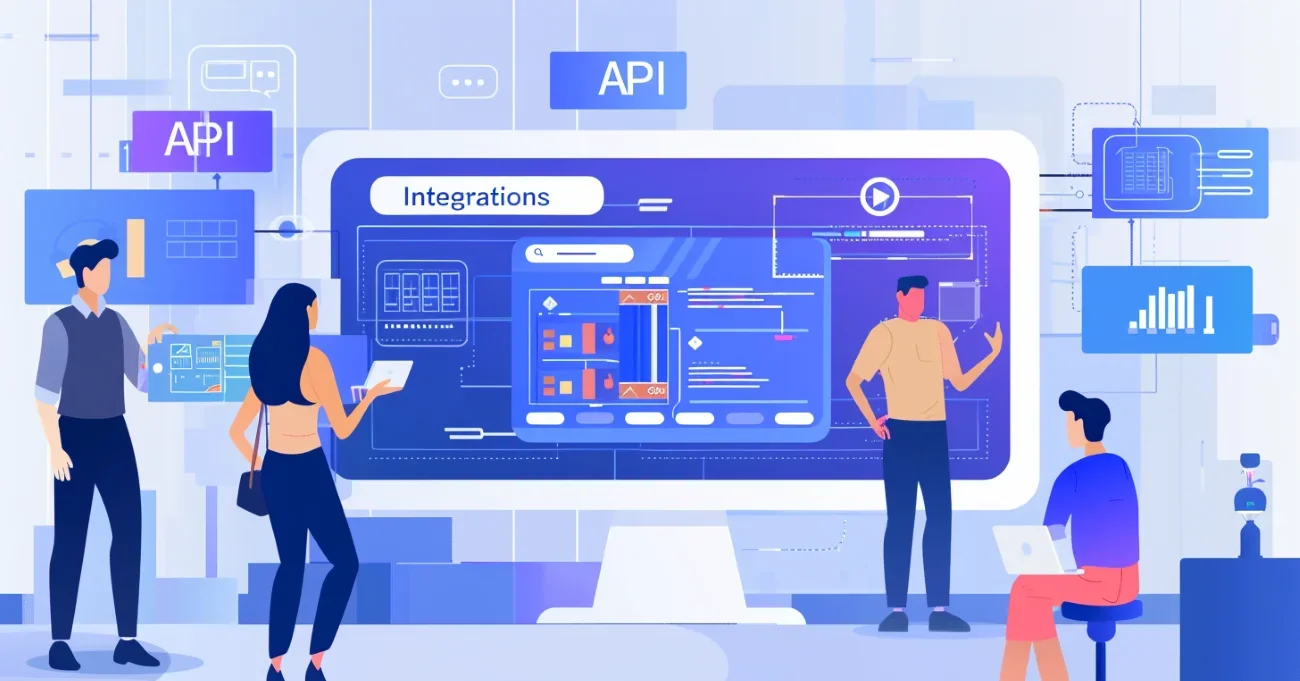API integrations are increasingly becoming the cornerstone of modern software development, enhancing application functionality, data exchange, and business processes. These integrations allow different software applications to communicate effortlessly, improving data transfer and streamlining operations. Through successful API integration, businesses can automate repetitive tasks, ensure seamless communication across various sources, and foster digital transformation.
Aloa, an expert in software outsourcing, stands at the forefront of implementing successful API integration strategies. With a deep understanding of the application programming interface (API), Aloa crafts tailored solutions that cater to the unique needs of businesses. Their approach ensures the seamless integration of SaaS applications, data sources, and business processes, ultimately enhancing the customer and user experience.
In this blog, you will understand what API integration is and how it works. We will also explore the common types of API integrations, the best practices to follow in connecting different software applications, and the benefits of API integration. Afterward, you'll understand how such integrations can catalyze business growth, supported by Aloa's extensive expertise and innovative software development and integration solutions.
Let's get started!
What are API Integrations?
API integrations are connections between different software applications via their APIs, allowing them to communicate and share data seamlessly. This essential technology allows for the automation of tasks and streamlined data exchange. Developers can create more efficient and effective software ecosystems that capitalize on the strengths of various platforms.
Integrating APIs allows disparate systems to communicate effortlessly, allowing businesses to consolidate data from various sources and streamline operations. With robust API integrations, businesses can strive for digital innovation and efficiency through connecting CRM systems, payment gateways, and IoT devices to various cloud services.
How do API Integrations Work?
API integrations facilitate seamless communication and data exchange between different applications, enabling them to work together efficiently. Understanding the mechanics behind API integrations is essential for developers and businesses aiming to leverage their capabilities effectively. Let’s explore these mechanisms in detail below.
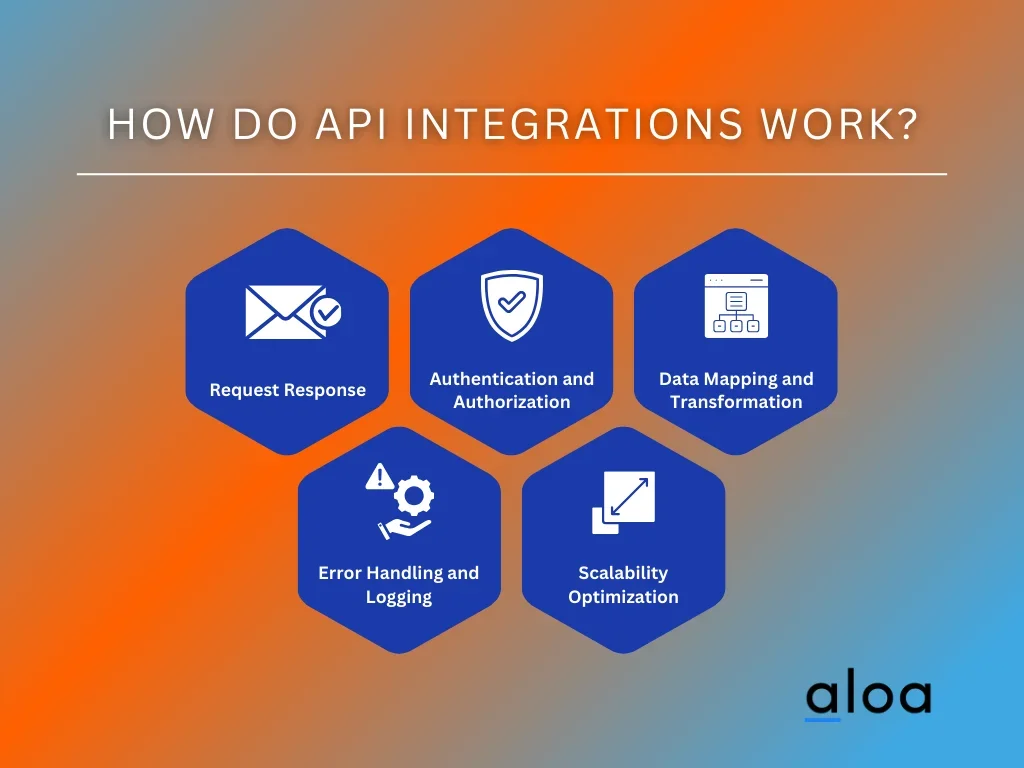
Request and Response Mechanism
Application programming interface (API) integration operates through a request and response mechanism. When one application requires data or functionality from another, it sends a request through the API. This request contains specific instructions or parameters outlining the desired action. The receiving application processes the request and generates a response containing the requested data or confirming the action's completion.
Here's how the request and response mechanism works:
- Initiating the Request: An application sends a request via the API, specifying the data or functionality it needs. This request, crafted according to the API's documentation, includes necessary parameters or commands.
- Processing the Request: The receiving application interprets the request, performs the required actions, retrieves the requested data, and prepares a suitable response. This step involves parsing the request, executing commands, and compiling the response data.
- Delivering the Response: The API then responds to the requesting application. This response, structured in a predefined format, confirms the completion of the requested actions or delivers the requested data, thus completing the integration cycle.
In this process, companies can unlock new possibilities for automation, efficiency, and innovation, ultimately driving growth and delivering superior value to their customers. Businesses can ensure they remain competitive in an increasingly connected and digital world through strategic implementation and management of integrating APIs.
Authentication and Authorization
Authentication and authorization mechanisms are integral components of integrating APIs. Before accessing data or services, the requesting application must authenticate its identity. This typically involves providing credentials or tokens to verify its legitimacy. Once authenticated, the API verifies the requesting application's permissions to ensure it is authorized to perform the requested actions.
Here are things to consider for authentication and authorization:
- Authentication: This is the first step in the security process, where the application proves its identity to the API. This is often done using API keys, client IDs, or tokens generated upon registration. The application must include these credentials in its requests to the API.
- Authorization: Once authentication is confirmed, the API checks whether the authenticated application has the necessary permissions for the requested operation. This step ensures that an application can only access resources and perform actions within its scope of authority.
These mechanisms not only protect sensitive information from unauthorized access but also play a crucial role in maintaining the overall security of the digital infrastructure. A robust authentication and authorization process is crucial as we rely more on interconnected systems.
Data Mapping and Transformation
Data mapping and transformation are essential for ensuring compatibility between integrated systems. APIs often use standardized formats for data exchange, such as JSON or XML. Before transmitting data, it may need to be mapped from one format to another to align with the receiving application's requirements. Such data may undergo transformation processes to ensure consistency and accuracy across systems.
Ensuring compatibility and integrity through effective data mapping and transformation, businesses can leverage API integrations to enhance their operations, make informed decisions, and provide better services. As the digital ecosystem continues to expand and evolve, the role of these processes in enabling the successful integration of APIs will only grow, underscoring their importance in the interconnected world of software applications.
Error Handling and Logging
Effective error handling and logging mechanisms are crucial for maintaining the reliability and stability of integrating APIs. Errors can occur for various reasons, such as invalid requests, network issues, or system failures. APIs must implement robust error-handling mechanisms to detect, report, and handle errors smoothly. Logging capabilities enable developers to track API usage, diagnose issues, and monitor performance over time.
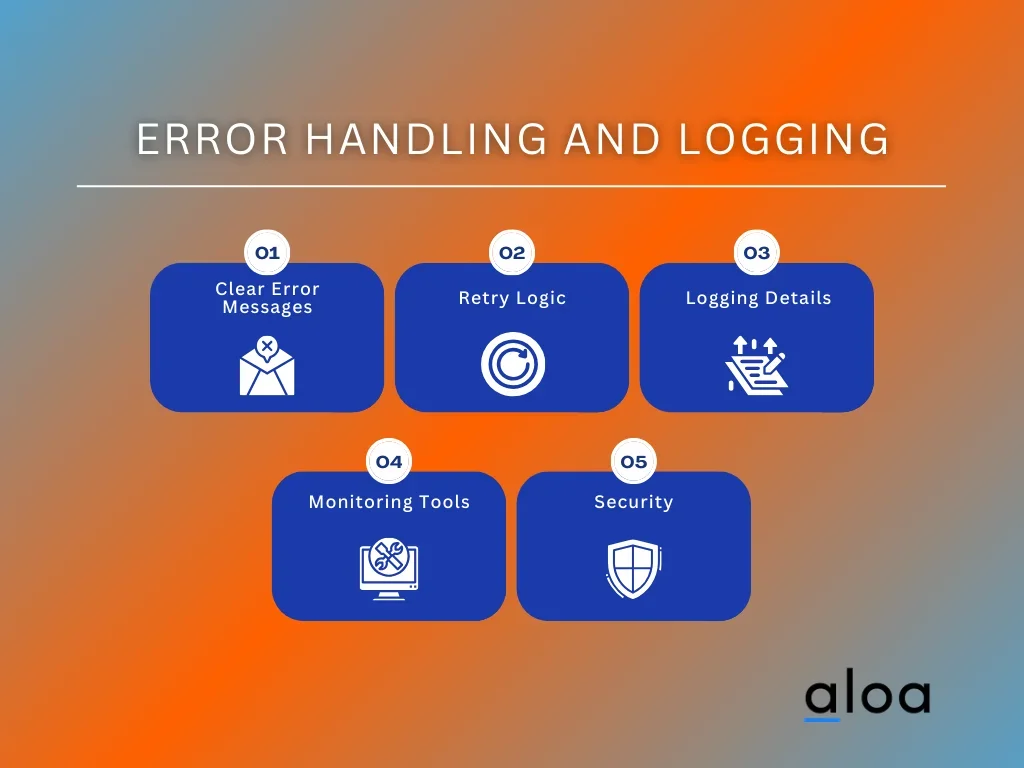
Considerations for robust error handling and logging in API integrations include:
- Clear Error Messages: Providing detailed, understandable error messages that help pinpoint the issue.
- Retry Logic: Implementing retry mechanisms for transient errors, such as network timeouts.
- Logging Details: Capturing essential information in logs, including request and response data, to aid in troubleshooting.
- Monitoring Tools: Utilizing monitoring tools to track real-time API performance and error rates.
- Security: Ensuring that error messages and logs do not expose sensitive information.
Effective error handling and logging are critical for integrating APIs smoothly. Developers can ensure their applications remain resilient and performant by preparing for potential errors and keeping detailed API interaction records. This approach not only aids in immediate issue resolution but also contributes to the long-term stability and reliability of the integrated software ecosystem.
Scalability and Performance Optimization
Scalability and performance optimization are critical considerations in API integration design. As the volume of requests increases or application requirements evolve, APIs must be able to scale seamlessly to accommodate growing demand. Performance optimization techniques, such as caching, asynchronous processing, and load balancing, help ensure efficient resource utilization and responsive API performance even under high loads.
These optimization efforts improve the responsiveness of APIs and ensure that as your user base grows, your system can adjust dynamically, maintaining optimal performance levels. Embracing these practices is essential for any organization looking to build scalable and high-performing APIs, ensuring they are prepared for future growth and technological advancements.
5 Common Types of API Integrations Used Today
API integrations are essential tools that allow software applications to communicate, share data, and enhance functionality across various platforms. Understanding the standard application programming interface integration types is essential for businesses and developers aiming to streamline processes and enhance efficiency.
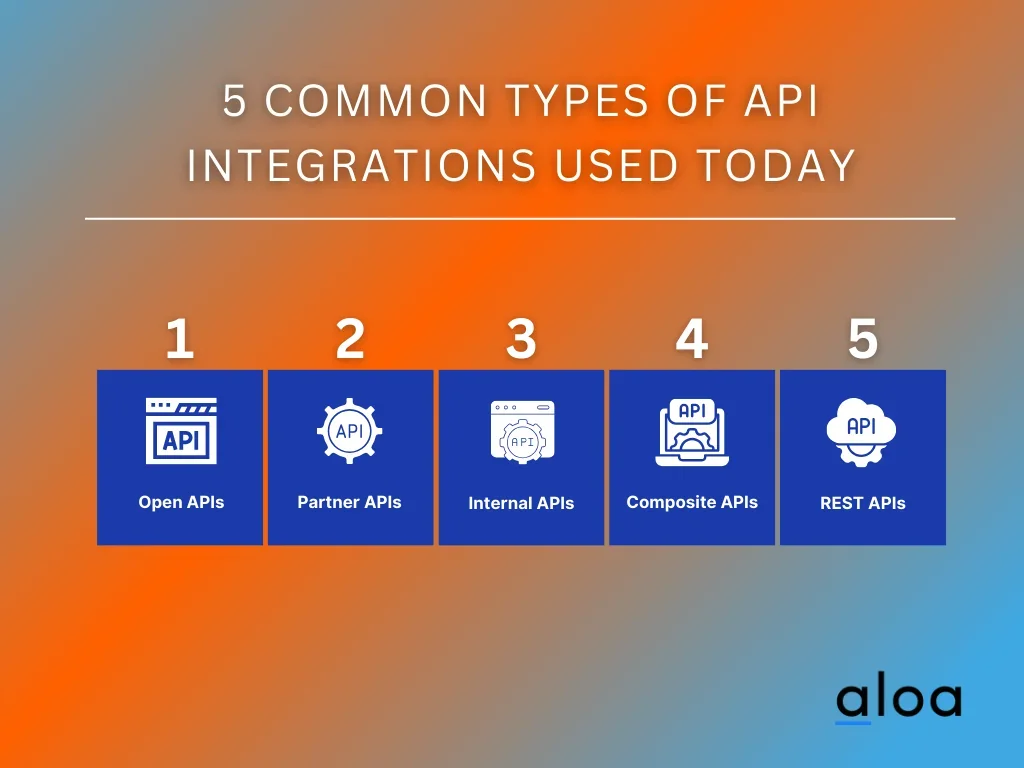
Let's explore five prevalent types of API integrations used today.
Open APIs
Open APIs provide innovation gateways, offering public access to an organization's services or data. They are vital in developing a collaborative and open internet ecosystem where developers can enhance their applications with features and functionalities sourced from across the globe. Open APIs fuel creativity and enable synergistic growth among businesses, developers, and end-users by democratizing access to data and services.
Open APIs Use Cases
- SaaS Apps: Enhance product offerings by integrating features from popular SaaS applications.
- Social Media Platforms: Facilitate sharing content directly to social media, broadening customer reach.
- Data Science: Allow access to datasets to analyze and develop new insights or services.
The strategic use of open APIs can significantly broaden an organization's reach and capabilities. They are essential tools for companies looking to stay competitive in a fast-paced digital economy, enabling them to tap into a global pool of resources and innovation.
Partner APIs
Partner APIs are tailored for exclusivity and efficiency, bridging specific businesses and their partners through secure, controlled access to each other's systems and data. These APIs cultivate a digital ecosystem where allied businesses can share resources and collaborate closely, optimizing their operations and delivering enriched customer services.
Partner APIs Use Cases
- Inventory Levels: Automate inventory updates between suppliers and retailers, ensuring accurate stock levels.
- Workflow Automation: Streamline operations by integrating disparate systems across business partners, reducing manual data entry.
- Customer Experience: Enhance the user interface by integrating partner services, offering customers a unified experience.
Leveraging partner APIs, companies can achieve integration and collaboration with their allies beyond surface-level interactions. These APIs enable the creation of a seamlessly interconnected suite of services and functions, providing a competitive edge and enhancing the value offered to customers.
Internal APIs
Internal APIs are the unsung heroes within organizations, working behind the scenes to connect and streamline internal operations and systems. These APIs are crucial in improving efficiency, enhancing data consistency, and supporting agile responses to business needs by facilitating communication between departments and their respective software systems.
Internal APIs Use Cases
- Data Mapping: Simplify the integration of different applications within an organization, ensuring consistent data across systems.
- Legacy Systems: Update and connect old systems with newer applications, extending their usability and integrating them into modern workflows.
- Real-Time Data Access: Enable departments to access real-time data across the organization, aiding decision-making and operational efficiency.
The strategic implementation of internal APIs can transform an organization's operational landscape, breaking down silos and fostering a culture of collaboration and efficiency. These APIs enhance internal workflows and pave the way for a more innovative and responsive business model.
Composite APIs
Composite APIs combine multiple API calls into a single call, making them ideal for handling complex integrations or sequences of tasks that must be executed smoothly. This method is particularly beneficial in complex integrations or when multiple interdependent operations must be performed efficiently.
Composite APIs Use Cases
- Performance Testing: Bundle API calls to test and improve the performance of interdependent services.
- Complex Integrations: Simplify the user experience by reducing the number of calls needed to perform a function across disparate systems.
- Efficiency: Improve communication efficiency between different platforms, reducing server load and speeding up the data flow.
Using composite APIs can significantly enhance application efficiency and performance, providing a streamlined way to handle complex system interactions and data exchanges. Optimizing the communication between different services and composite APIs improves the speed and reliability of applications and offers developers a more efficient way to build and maintain integrations.
REST APIs
REST APIs have emerged as the backbone of web services, offering a flexible, lightweight approach to building API integrations. Utilizing the ubiquitous HTTP protocol, REST APIs facilitate straightforward and efficient communication between computers over the Internet. Their simplicity, scalability, and ease of use have made them a preferred choice for developers aiming to create seamless interactions between different software systems.
REST APIs Use Cases
- Cloud Services: Integrate with cloud-based services like Microsoft Azure for scalable and flexible IT infrastructures.
- Mobile Applications: Develop seamless connections between mobile apps and databases, enhancing the user interface and experience.
- Security Testing: Ensure secure data exchange between services, applying stringent security testing measures.
Adhering to the principles of representational state transfer, REST APIs provide a scalable and easy-to-use framework for developers, enabling the creation of robust and efficient integrations. As digital ecosystems continue to evolve, the versatility and simplicity of REST APIs will ensure continued integration and interoperability.
Importance of API Integrations
API integrations facilitate seamless communication and data exchange between diverse applications and systems in today's interconnected digital landscape. These integrations empower businesses to streamline operations, enhance efficiency, and deliver enhanced user experiences. Understanding the significance of integrating APIs is crucial for businesses aiming to stay competitive and agile in the modern market.
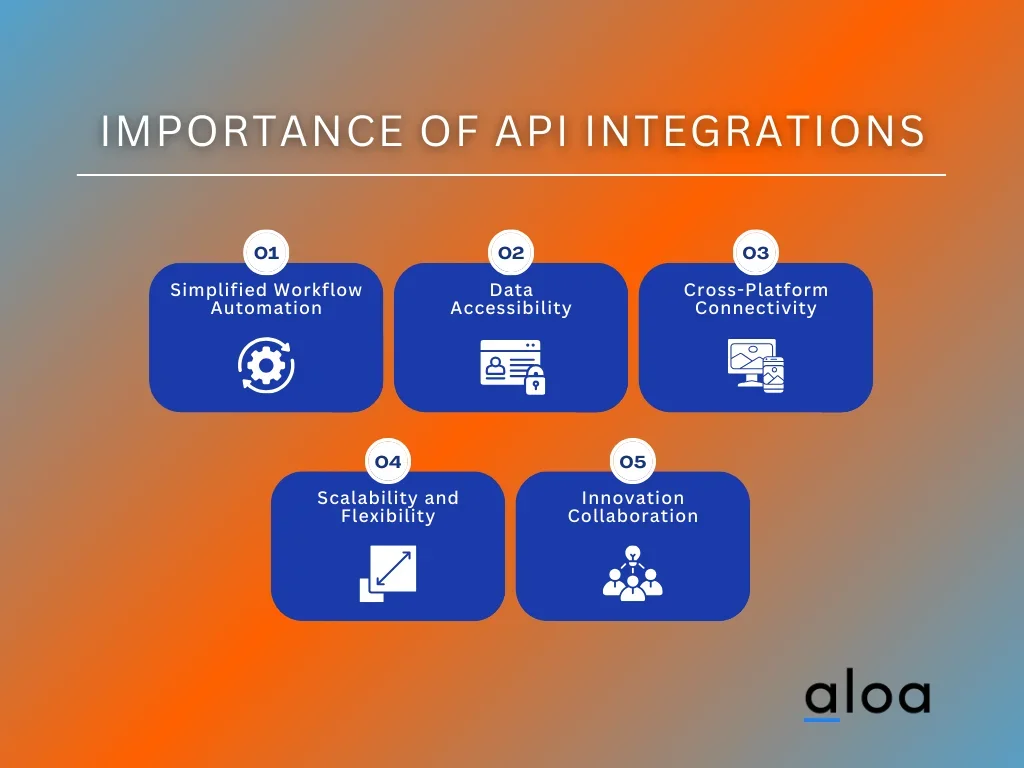
Simplified Workflow Automation
API integrations enable businesses to automate various processes, reducing manual intervention and increasing operational efficiency. Seamlessly connecting different software solutions, tasks such as data entry, report generation, and communication can be automated, allowing employees to focus on more strategic initiatives. This streamlining of workflows saves time and minimizes the risk of errors, leading to improved productivity and cost savings.
Enhanced Data Accessibility and Utilization
Businesses can access and leverage data from multiple sources in real time by integrating APIs. This accessibility to diverse datasets empowers organizations to gain deeper insights, make informed decisions, and personalize customer experiences. Whether it's analyzing customer behavior, tracking inventory levels, or monitoring market trends, API integrations enable businesses to maximize the value of their data assets, driving innovation and growth.
Seamless Cross-Platform Connectivity
With the proliferation of devices and platforms, providing a seamless user experience across multiple channels has become imperative for businesses. API integrations allow applications to communicate effortlessly across different platforms, ensuring consistent user experiences regardless of their device or operating system. As businesses integrate these APIs, they can maintain a cohesive presence and engage users effectively, whether accessing services through a website, mobile app, or third-party platform.
Scalability and Flexibility
Integrating APIs allows businesses to adapt to changing requirements and scale their operations accordingly. Whether expanding into new markets, integrating additional functionalities, or accommodating fluctuations in demand, APIs allow businesses to scale their infrastructure and services without significant overheads or disruptions.
Facilitates Innovation and Collaboration
API integrations foster innovation by enabling businesses to leverage external resources, services, and technologies. Integrating with third-party APIs, organizations can access various tools, functionalities, and data sources that complement their offerings. This collaboration fosters creativity and experimentation, accelerating time-to-market for new products and services. Integrating APIs facilitates partnerships and collaborations between businesses, opening up new avenues for growth and differentiation in the market.
Best Practices to Follow When Using API Integrations
Leveraging application programming interface integration enables seamless system interaction, enhancing functionality and streamlining processes. However, it's essential to adhere to best practices to maximize the benefits of API integration while minimizing potential pitfalls.

Thorough Documentation
Comprehensive documentation stands as the cornerstone of successful API integration. Developers can easily navigate integration processes by providing precise and concise instructions on API endpoints, parameters, authentication methods, and response formats. Adequate documentation facilitates swift implementation and promotes better understanding, enabling developers to troubleshoot issues efficiently.
Prioritize Security Measures
Security remains crucial in integrating APIs to safeguard sensitive data from unauthorized access or manipulation. Implementing robust authentication mechanisms such as OAuth 2.0 or API keys adds layers of protection, ensuring only authorized entities can access resources. Employing HTTPS encryption and adhering to industry-standard security protocols further fortifies defenses against threats like data breaches or injection attacks.
Optimize Error Handling
Effective error-handling mechanisms are pivotal in maintaining the reliability and resilience of integrating APIs. Defining clear error codes and messages, developers can promptly identify and troubleshoot issues encountered during integration. Also, implementing retry mechanisms and incorporating descriptive error responses empower developers to rectify errors swiftly, minimizing disruptions and improving application functionality and user experience.
Version Control Implementation
As APIs evolve to introduce new features or enhancements, version control becomes imperative to manage compatibility and ensure seamless transitions. Developers can introduce updates without disrupting existing integrations by adopting versioning schemes such as Semantic Versioning (SemVer). Delineating version changes and providing backward compatibility guidelines enable stakeholders to make informed decisions regarding API upgrades while mitigating compatibility issues.
Performance Optimization Strategies
Efficient performance is integral to integrating APIs seamlessly, especially in high-demand environments. Techniques like caching frequently requested data, implementing asynchronous processing, and optimizing payload sizes enhance response times and scalability. Regular performance monitoring and tuning enable developers to identify bottlenecks and fine-tune integration processes for optimal efficiency and responsiveness.
Key Takeaway
Staying updated with the latest trends in API integrations is crucial for startups and businesses aiming to stay competitive. These integrations facilitate seamless connections between software applications, enhancing functionality and user experience. As the digital landscape evolves, quickly integrating and adapting these systems becomes indispensable for operational efficiency and innovation.
That said, startups and businesses need to recognize the importance of integrating APIs. Implementing these technologies can dramatically improve data flow, automate tasks, and open new collaboration and service delivery channels. With the right API strategy, companies can enhance their agility and respond to market changes and customer needs easier.
Sign up for the Aloa email list today to navigate the complexities of integrating APIs and stay ahead of the curve. You may also explore the Aloa blogs to stay updated of the emerging trends in the API space, enhancing your API strategy and implementation efforts. Whether you're looking to boost your current systems or build new capabilities, Aloa offers the guidance and tools to make the most of your API integrations.

